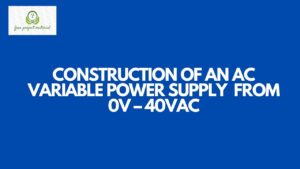ABSTRACT
This project entitled “Cable Sizing For Solar Power” was aimed at highlighting ways of calculating the size of solar cable use for connecting solar panel to appliances such as inverter. Solar and photovoltaic cables are those that are used for the transmission of power in a solar or PV installation. These cables are specific for the solar and PV industry and thus have certain approvals that are required. Solar cable calculations are primarily used in residential and large scale solar installation. The specific areas that these cables are used for in these calculations include: Panel to Combiner Box, Combiner Box to Power Inverter, and Power Inverter to Transformer. It is recommended that every solar installation must follow and used the calculation for proper and safe installation.
Table of Contents
ToggleTABLE OF CONTENTS
TITLE PAGE – – – — – – – – –
APPROVAL PAGE – – – – – – – –
CERTIFICATION – – – – – – – –
DEDICATION – – – — – – – –
ACKNOWELDGEMENT – – – – – – –
ABSTRCT – – – – – – – – –
TABLE OF CONTENT – – – – – – –
CHAPTER ONE
1.1 INTRODUCTION – – – – – – –
1.2 AIM OF THE STUDY – – – – – –
1.3 OBJECTIVE OF THE STUDY – – – – –
1.4 SIGNIFICANCE OF THE STUDY – – – – —
1.5 APPLICATION OF THE STUDY – – – – –
1.6 SCOPE OF THE STUDY – – — – – –
1.7 FACTORS DETERMINING THE SOLAR CABLE SIZE – –
CHAPTER TWO
LITERATURE REVIEW
2.0 LITERATURE REVIEW – – — – – –
2.1 OVERVIEW OF THE STUDY – – — – –
2.2 REVIEW OF PHOTOVOTAIC SYSTEM – – – –
2.3 DESCRIPTION OF PHOTOVOLTAIC SYSTEM – – –
2.4 SOLAR CABLE INSULATION – – — – –
2.5 SOLAR CABLE CONNECTION – – – — –
2.6 SOLAR CABLE LOSS MINIMIZATION – – – –
2.7 UL4703 STANDARD OF SOLAR CABLE – – – –
CHAPTER THREE
3.0 METHODOLOGY – – – – – – –
3.1 SOLAR CABLE CONDUCTOR MATERIAL AND INSULATION –
3.2 CABLE SPECIFICATION – – — – – –
CHAPTER FOUR
4.1 SOLAR WIRE TYPES – – – — – –
4.2 PV WIRE RATINGS – – – — – – –
4.3 SOLAR WIRE THICKNESS – – – — – –
4.4 PV WIRE LENGTH – – – — – – –
4.5 PV WIRE GAUGE GUIDE – – — – – –
CHAPTER FIVE
5.1 CONCLUSIONS – – – — – – –
5.2 RECOMMENDATION – – – – – –
REFERENCES
CHAPTER ONE
1.1 INTRODUCTION
Solar energy is a type of renewable energy which is extracted by the light of sun by various modes of existing technologies like Solar cells, Photosynthesis, Photovoltaic and solar power plants. It is an important source of energy. The two techniques that are Active Solar and Passive Solar are used for the extraction of the energy from the sunlight. Over the time Solar Energy has proved to be an efficient and a clean source of energy and the connection of solar energy is done using cable.
A solar cable is the interconnection cable used in photovoltaic power generation. Solar cables interconnect solar panels and other electrical components of a photovoltaic system. Solar cables are designed to be UV resistant and weather resistant. They can be used within a large temperature range and are generally laid outside.
One common factor for most of the photovoltaic power systems is outdoor use, characterized by high temperatures and high UV radiation. Single-core cables with a maximum permissible DC voltage of 1.8 kV Umax. The phase to ground DC voltage rating must be Uo1.5kVDC and a temperature range from -40 °C to +90 °C ambient, 120 °C on the conductor for 25 year service life against thermal ageing. Ambient temperature and conductor temperature is derived from the Arrhenius law for ageing of polymers – ageing of polymers doubles for every 10 °C rise.
Solar cables must be class II double insulated to protect against short circuits and ground faults.
1.2 AIM OF THE STUDY
The aim of this work is to highlight ways of calculating the size of solar cable use for connecting solar panel to appliances such as inverter.
1.3 OBJECTIVE OF THE STUDY
At the end of this work students involved will be able to:
- The right size of the wire to be used for solar power connection.
- The reason for using the right size of solar cable
- The effect of using wrong cable in a solar energy connection
1.4 SIGNIFICANCE OF THE STUDY
Solar cables are used in all photovoltiac systems for cabling of the solar modules and as a connection to the AC/DC inverter. Solar cable is single core cables are weather, abrasion and UV-resistant, with a reduced outer diameter for weight and space saving installations. These halogen free, double insulated, cross-linked solar cables are suitable for permanent outdoor use. They are for use on photovoltaic systems both for cabling of solar modules among themselves and as connection to the DC / AC inverter.
1.5 APPLICATION OF THE STUDY
This study is used for calculating the cable size of all solar connections such as:
- solar battery charger
- Solar inverter
- Solar lighting system
- Solar street light, etc.
1.6 SCOPE OF THE STUDY
It is extremely important to use the correct solar cable size when connecting various components of a solar energy system. Properly sizing the cables ensures that there is practically no overheating and very little loss of energy. Using an undersized cable not only poses a potential for causing fire due to overheating, but is also a code violation in most jurisdictions. In a typical solar power system, wiring is needed to connect these four components together:
- The solar panel (used to generate electricity)
- The inverter (used to convert DC electricity to AC, as most of our home appliances need AC input) And for Off-Grid systems:
- The charge controller (used to prevent the batteries from over charging)
- The batteries (used to store electrical energy for later use)
1.7 FACTORS DETERMINING THE SOLAR CABLE SIZE
The size of the wire to be used depends upon:
- The generating capacity of the Solar Panel (larger the current generated, bigger the size)
- The distance of the Solar Panel to the loads (greater the distance, bigger the size.


